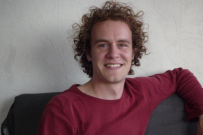Improving the electrolyte – cathode assembly for mt-SOFC
Promotion date: 10. June 2011
Promotor: Prof. dr. ing. Dave Blank
Assistant: Dr. Bernard Boukamp
| In the long road towards commercialization of Solid Oxide Fuel Cells, improving the cathode’s performance is a major milestone. Achieving low Area Specific Resistances at temperatures around 600 °C are required to meet the market demands in terms of costs and lifetime. In this thesis, different research projects focusing on the electrolyte / cathode assembly are described with as aims: an improvement of the performance and a better understanding of the cells. To decrease the Area Specific Resistance (ASR) of the cathodes, two solutions are explored and combined in this thesis. The first possibility is to replace the-state-of-the-art cathode materials by new and innovative materials. A study on Lanthanum Nickelate (La2NiO4+δ) as a porous electrode is shown This material shows excellent oxygen surface exchange and ionic diffusion. The second possibility is to use one of the state-of-the-art materials and improve its microstructure. By engineering the electrolyte / cathode interface, it is shown for La0.6Sr0.4Co0.2Fe0.8O3-δ and for La2NiO4+δ that the oxygen surface transport on the cathode grains can be enhanced. The trick consists of introducing a thin dense layer of the cathode material between the porous electrode and the electrolyte. Finally, a new method to produce a complete cell with Pulsed Laser Deposition is presented. PLD is a typical example of what nanotechnology can bring to improve Solid Oxide Fuel Cells. |
Were some surprising results obtained during your thesis project?
Besides studying performance differences of various materials in SOFC cells, we managed to produce a thin, dense layer of cathode material between 200 – 800 nm, which we placed strategically in the cell. By doing so, the resistance of the active ions was lowered by a factor three, allowing the performance temperature of the cell to lower up to 75 degrees Celsius.
This was a major result.
In fact, by adding this layer the oxygen ions transfer from the cathode to the electrolyte was improved. One possible reason for this improvement might be that the thin layer is providing extra sites for oxygen transfer at a very strategic place, next to the electrolyte surface.
Was your work application driven, or more fundamental of nature?
The thesis was part of a SenterNovem project involving for example ECN in Petten, TU Delft and some companies working on this. However, the project changed during my period working on it, as ECN stopped its research in Solid Oxid Fuel Cells.
Foreign research groups are now working on it further. Also the Inorganic Materials Science group will continue the scientific work.
I had some nice publications in Solid State Ionics, an important journal in this field. We are still working on publishing some important results.
As a scientist and researcher, what did you learn from these experiences?
In order to continue the work successfully, one has to use his warm contacts right away if the surroundings of the project are changing. Using informal contacts - not necessarily along the official lines of research planning and social meetings – provides the opportunity to reach your own research ends.
In academic research this is very important, as you are in every aspect the carrier of your own research project.
What are your future plans?
Right now, I am working at Avantor Performance Materials, a worldwide company producing advanced materials components in all different kind of applications. I am still working in the new energy field, finding chemical solutions to reduce production costs and improve the efficiency of solar cells.
Is this different from working in an academic environment?
I like the fact that clients and other stakeholders have their say in my projects, which leads to a dynamic research process. Also I am using my soft skills more here, like explaining to non-experts what the science is all about and what expectations research can fulfil. Or can not fulfil.
What, in your opinion, is important for Mesa+ to stay successful in the near future?
Mesa+ is well-known at all kinds of levels: internationally on congresses, nationwide at universities and institutes, and in daily work being able to use up-to-date facilities and the knowledge present, to use these efficiently.
I think it is important to find new market-driven research areas as is for example new energy. This is a real issue in the European Union at the near future. I think energy sources will diversify per application more and more. Nanotechnology can contribute on small-scale energy harvesting methods, also on large scale system improvements, like I showed in my research on fuel cells by using smart thin layers.

